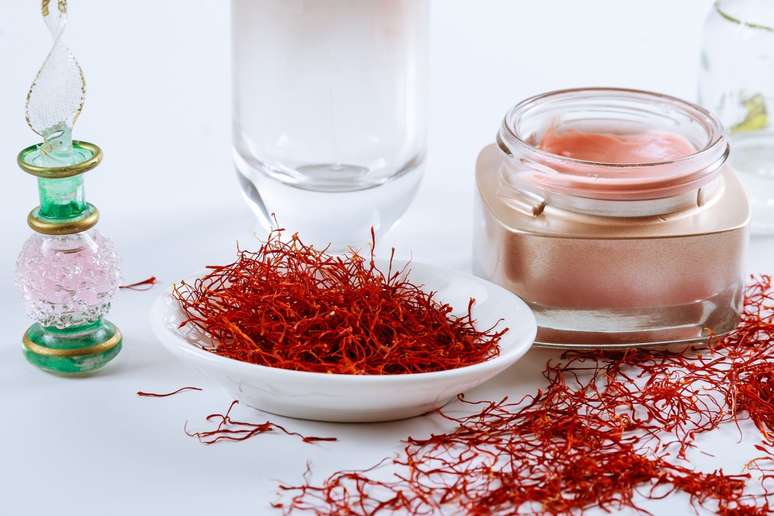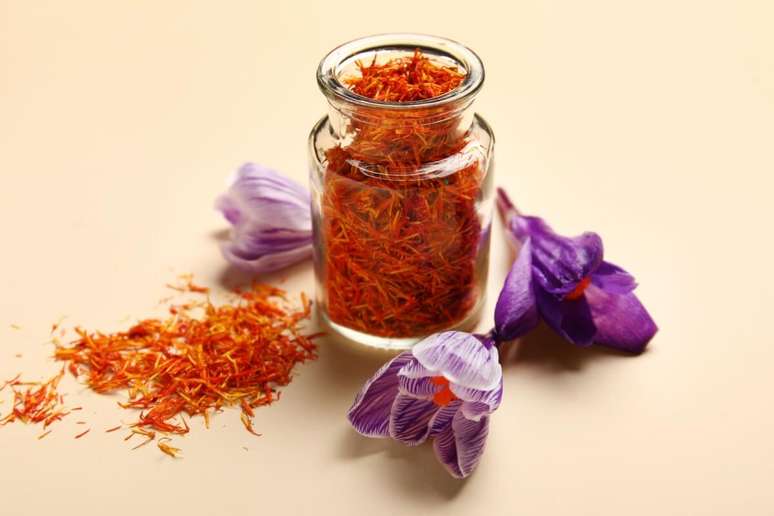The richness of nutrients in this plant provides positive effects for the body and mind
Originating from delicate flowers, saffron (Crocus sativus) is considered one of the most valuable ingredients in the world, both for its rarity and its exceptional properties. Its high cost is due to the laborious cultivation and harvesting process: to produce just 1 kg of saffron, approximately 250,000 flowers are needed, since each flower contains only three stigmas.
Below, discover 7 health benefits of this ancient spice and how to use it!
1.Pprotection against oxidative damage
Saffron is rich in antioxidants such as crocin, crocetin, safranal and kaempferol. These compounds neutralize free radicals, protecting cells from oxidative damage that leads to premature aging and cardiovascular and chronic diseases.
2. Support for eye health
Saffron contains crocin, a carotenoid that protects retinal cells from degeneration and oxidative stress. According to the article published on Hypothesis Medical discovery and innovation in ophthalmology (2024), titled “Crocus sativus (saffron) and age-related macular degeneration (ARMD)“, saffron shows promising effects in the management of age-related macular degeneration.
The review highlighted that saffron’s active compounds, such as crocin and crocetin, have demonstrated significant benefits in improving visual function and slowing disease progression in both dry and wet forms. However, the authors highlight the need for longer and more comprehensive investigations to confirm its long-term efficacy and safety.
3. Supports digestive health
Saffron has antispasmodic and antacid properties that help relieve the symptoms of digestive disorders such as intestinal cramps, reflux and abdominal swelling. Its ability to stimulate the secretion of digestive enzymes promotes the absorption of nutrients and the healthy functioning of the gastrointestinal system.
4. Menstrual pain relief
Saffron is traditionally used to relieve menstrual cramps due to its antispasmodic action and ability to reduce excessive flow. It also helps regulate menstrual cycles in women with hormonal disorders, being an ally in conditions such as polycystic ovary syndrome (PCOS). However, its use should not replace medical monitoring and treatment.

5. Helps with whitening and skin care
Saffron has gained space in cosmetics thanks to its effective lightening and evening out skin tone action, attributed to crocin and safranal, compounds with antioxidant and anti-inflammatory properties. These natural actives help reduce melanin production, fighting dark spots and hyperpigmentation while promoting a healthy glow.
Furthermore, its application in creams, serums and face masks helps protect against damage caused by free radicals, delaying the signs of aging, such as wrinkles and fine lines. Versatile, saffron also acts as a calming agent for sensitive skin, being widely used in products designed to revitalize and brighten the face.
6. Helps with wound healing
According to the article”In vitro and in vivo evaluation of the diabetic wound healing properties of saffron petals (Crocus Sativus L.)“, published in Scientific reports In August 2024, saffron petal extract was shown to be a promising solution for accelerating wound healing, especially in the context of diabetes.
Research has shown that saffron petal extract helps skin cells grow faster, move to close the wound, and form new blood vessels. This happens because saffron increases its production collagena protein that strengthens the skin and substances that stimulate blood flow. In animal tests, use of the extract reduced the time needed for wounds to heal.
7. Promising alternative in the treatment of depression
In a review published on Yale Journal of Biology and Medicine in September 2024, titled “Exploring the potential of saffron as a therapeutic agent in the treatment of depression: a comparative review“, researchers analyzed the evidence on the use of turmeric in the management of depression.
The study concluded that active compounds in saffron, such as crocin, crocetin, and safranal, can alleviate depressive symptoms through mechanisms such as neurotransmitter regulation, neuroprotection, and anti-inflammatory effects. However, the authors highlight the need for larger, long-term studies to confirm its safety, determine the optimal dosage, and explore its full therapeutic potential.
How to use saffron
Saffron, in addition to its health benefits, is a versatile ingredient that can be easily incorporated into your dietary routine and daily care. However, its use requires attention to maximize its properties without waste. Here are some simple and effective ways to use it:
- Infused in water or milk: put a few threads of saffron in hot water or warm milk, leave to infuse for about 10 minutes and use in recipes or consume directly. This technique helps release active compounds, such as crocin and safranal;
- Saffron in savory dishes: add saffron to risottos, soups or meat dishes, previously dissolving the filaments in a hot liquid for better distribution of flavor and colour;
- Preparation of the dessert: Saffron can be used in puddings, ice cream or cakes, adding a sophisticated touch. Mix the hydrated strands with the dough or cream;
- Tea and drinks: use a small amount of saffron in herbal teas or smoothies to take advantage of its antioxidant benefits;
- Homemade face masks: Mix turmeric with honey or yogurt to create a mask that improves skin brightness and helps reduce inflammation;
- Supplements in capsules or powder: for those who prefer practicality, saffron is also available in the form of supplements to be taken daily;
- Tincture for topical use: In cases of medicinal use, such as wound healing, turmeric can be made into a homemade tincture by mixing it with alcohol or coconut oil.
Source: Terra
Ben Stock is a lifestyle journalist and author at Gossipify. He writes about topics such as health, wellness, travel, food and home decor. He provides practical advice and inspiration to improve well-being, keeps readers up to date with latest lifestyle news and trends, known for his engaging writing style, in-depth analysis and unique perspectives.









